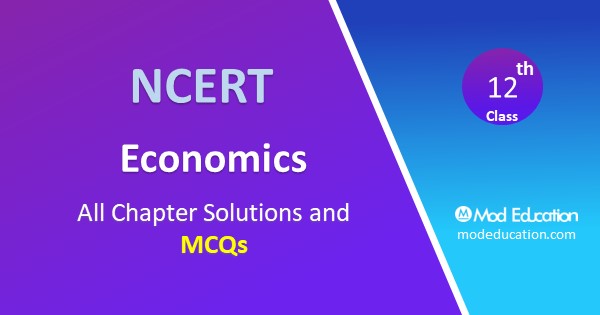MCQ Questions for Class 12 Economics Chapter 4 : Class 12 Chapter 4 “Determination of Income and Employment” MCQ Questions for Class 12 Economics with Answers PDF Free Download here according to the latest CBSE syllabus and NCERT curriculum.

MCQ Questions for Class 12 Economics Chapter 4 Determination of Income and Employment with PDF
Here CBSE RBSE and Other State Board NCERT Objective MCQ Questions of Class 12 Economics Chapter 4 “Determination of Income and Employment” with Answers Pdf will guide students to do a quick revision for all chapter.
Q1. What is the cause of Keynesian perfectly elastic Aggregate Supply curve?
(A) Wage price rigidity
(B) Constant Marginal Product of Labour
(C) Both of these
(D) None of these
(C) Both of these
Q2. According to classical economists, there always exists __ equilibrium in the economy.
(A) Full employment
(B) Underemployment
(C) Over full employment
(D) None of these
(A) Full employment
Q3. What will be APC when APS = 0?
(A) One
(B) Zero
(C) Two
(D) Infinite
(A) One
Q4. If the income is ₹ 400 crores and consumption is ₹ 250 crores, what will be the APC?
(A) 0.67
(B) 0.63
(C) 0.60
(D) 0.58
(B) 0.63
Q5. What is a fiscal measure of correcting deficient demand?
(A) Increase in public expenditure and decrease in taxes
(B) Decrease in public debt
(C) Deficit financing
(D) All of these
(D) All of these
Q6. Which is the measure of correcting excess demand?
(A) Deficit financing
(B) Reduction in taxes
(C) Increase in public expenditure
(D) Increase in public debt
(D) Increase in public debt
Q7. Suppose in a hypothetical economy, the income rises from ₹ 5,000 crores to ₹ 6,000 crores. As a result, the consumption expenditure rises from ₹ 4,000 crores to ₹ 4,600 crores. Marginal propensity to consume in such a case would be __
(A) 0.8
(B) 0.4
(C) 0.2
(D) 0.6
(D) 0.6
Q8. On the basis of government law, the compulsory payment made by the public is known as _
(A) Expenditure
(B) Investment
(C) Tax
(D) Subsidy
(C) Tax
Q9. Which among is the direct tax?
(A) Income tax
(B) Gift and Corporation tax
(C) Wealth tax
(D) All of these
(D) All of these
Q10. The value of multiplier is:
(A) 1MPC
(B) 1MPS
(C) 11−MPS
(D) 1MPC−1
(B) 1MPS
Q11. If MPC = 1, the value of the multiplier is:
(A) 0
(B) 1
(C) Between 0 and 1
(D) Infinity
(D) Infinity
Q12. Aggregate demand can be increased by:
(A) increasing bank rate
(B) selling govt, securities by RBI
(C) increasing cash reserve ratio
(D) none of these
(D) none of these
Q13. If the marginal propensity to consume is greater than the marginal propensity to save, the value of the multiplier will be
(A) greater than 2
(B) less than 2
(C) equal to 2
(D) equal to 5
(A) greater than 2
Q14. Supply creates its own Demand. Who gave this law?
(a) J.B.Say
(b) J.S.Mill
(c) Keynes
(d) Ricardo
(a) J.B.Say
Q15. Who is the author of the book ‘General Theory of Employment, Interest, and Money’?
(a) A.C. Pigou
(b) Malthus
(c) J.M. Keynes
(d) Marshall
(c) J.M. Keynes
Q16. Which of the following is true for the Classical Theory of Employment?
(a) State of full employment in the economy
(b) No possibility of over-or under-production in the economy
(c) Both (a) and (b)
(d) None of the above
(c) Both (a) and (b)
Q17. On which factor Keynesian Theory of Employment depends?
(a) Effective Demand
(b) Supply
(c) Production Efficiency
(d) None of the above
(a) Effective Demand
Q18. Which is the determining factor for investment?
(a) Marginal Efficiency of Capital
(b) Interest Rate
(c) Both (a) and (b)
(d) None of these
(c) Both (a) and (b)
Q19. According to Keynes, investment implies:
(a) Financial Investment
(b) Real Investment
(c) Both (a) and (b)
(d) None of the above
(b) Real Investment
Q20. With the increase in investment, MEC:
(a) Rises
(b) Falls
(c) Remains Constant
(d) None of these
(b) Falls
Q21. Which of the following is a Read Investment?
(a) Purchasing of a Share
(b) Purchasing of Old Factory
(c) Construction of Buildings
(d) Opening Deposit Account in the Bank
(c) Construction of Buildings
Q22. APC + APS = ?
(a) ?
(b) 2
(c) 1
(d) 0
(b) 2
